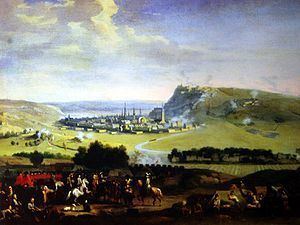8,000 12,000 | Dates 2 Jul 1695 – 1 Sep 1695 | |
 | ||
13,000 34,000 infantry24,000 cavalry Similar Nine Years' War, Battle of Landen, Battle of Steenkerque, Battle of Leuze, Battle of Fleurus | ||
The Siege of Namur, 2 July – 1 September 1695, was the second siege of the city of Namur in the Nine Years' War. The Allied forces of the Grand Alliance retook the city from the French, who had captured it in the first siege in 1692. The recapture of Namur has been called the most important event in the Nine Years' War.
Contents
Background
The French captured the city of Namur in the first siege in 1692, under the command of the Duc de Luxembourg, with King Louis XIV of France present. Namur's defensive works had been designed by Menno van Coehoorn, who oversaw the citadel's defence during the first siege. His French counterpart, Vauban improved the defensive works significantly after the city was taken. Given its strategic position at the confluence of the Sambre and Meuse rivers, the Citadel of Namur became the most strategically important fortress in the Spanish Netherlands.
Siege
As France was on the defensive, the Allied army of the Grand Alliance under the command of King William III of England (who commandeered the Château de La Falize as his headquarters), and Maximilian II Emanuel of Bavaria, governor of the Spanish Netherlands, laid siege to the city beginning on 2 July 1695. By 3 July, they had invested the city. Menno van Coehoorn, in a reversal of roles, directed the siege works against the city.
By 18 July, Allied forces had overcome the outer fortifications that Vauban had built. Five battalions of English and Dutch troops launched an assault on the Brussels Gate of Namur. The general assault began on 3 August, and the Duc de Boufflers, the French commander, offered the surrender of the city. The offer was accepted, and the following day as part of the terms of surrender a six-day truce was granted to attend to the wounded and withdraw to the citadel. The truce was guaranteed by an exchange of high-ranking officers as hostages; after the six days had expired, the hostages returned to their camps and the siege of the citadel was renewed.
The Duke of Villeroi made an attempt to draw the attackers away from Namur by bombing the militarily unimportant target of Brussels, with the goal only of causing destruction to the city. The bombardment lasted from 13 – 15 August, and did not divert any Allied troops from the siege of Namur. Villeroi's army later attempted to lift the Allied siege of Namur, but it was blocked in the field by an army under the Prince of Vaudemont.
After a further month of resistance, Boufflers surrendered the citadel to the besieging army on 1 September, having lost 8000 of his 13,000 men. The Allies lost 12,000 men. William had Boufflers detained, as Boufflers had violated the terms of surrender and treated Allied prisoners of war poorly after battles at Deinze and Dixmuide.
English, Scottish, Irish and Welsh Regiments at the siege
Although not awarded until 1910, fourteen regiments from England, Scotland, Ireland and Wales bear "Namur 1695" as a Battle honour including the Grenadier Guards, the Coldstream Guards, the Scots Guards, The Royal Scots, The King's Own Scottish Borderers, The Royal Irish Regiment, The Welch Fusiliers, the Queen's Royal Surreys, the East Yorkshire Regiment, the West Yorkshire Regiment the King's Own Royal Regiment, the King's Own Royal Border Regiment the Sunderland Fusiliers and the Royal Warwickshire Fusiliers. Other regiments taking part included the Bedfordshire Regiment
In Tristram Shandy
In Laurence Sterne's novel Tristram Shandy, Tristram's uncle Toby injured his groin at the Siege of Namur. A major subplot of the novel involves his obsession with the siege and reenacting battles from the war with his trusty sidekick, Corporal Trim. He builds a complete replica of the battle in his garden, which he shows to his fiancée Widow Wadman, who keeps trying to find out how serious his groin injury is before committing to marry him, but who is always fobbed off with increasingly elaborate accounts of the siege. The siege and Toby's reconstruction of it are featured in the film version of the novel, A Cock and Bull Story (2006).
